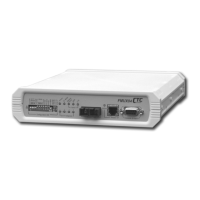Chapter 4. SNMP
37
Chapter 4. SNMP
4.1 General
The Simple Network Management Protocol (SNMP) is one of many protocols in the Internet
Protocol (IP) suite. SNMP is the protocol recommended specifically for the exchange of
management information between hosts residing on IP networks. Network management
allows you to monitor and control network devices remotely using conventional computer
network technology.
The SNMP management functions of the FMUX04 are provided by an internal SNMP agent,
which utilizes out-of-band communication over standard 10Base-T or 100Base-TX Ethernet.
The SNMP agent is compliant with the SNMPv1 standard. SNMP communications use the
User Datagram Protocol (UDP). UDP is a connectionless transport protocol, part of the
TCP/IP suite. The SNMP application uses an asynchronous command/response polling
protocol and operates at the OSI Layer 7 (Layer 7 is the Application Layer. Other IP
applications that operate at this layer are FTP, Telnet, HTTP, SMTP, etc.). All management
traffic is initiated by the SNMP-based network management station. Only the addressed
managed entity (agent) answers the polling of the management station (except for trap
messages).
4.2 SNMP Operations
The SNMP protocol includes four types of operations:
getRequest Command for retrieving specific value of an "instance"
from the managed node. The managed node responds
with a getResponse message.
getNextRequest Command for retrieving sequentially specific
management information from the managed node.
The managed node responds with a getResponse
message.
setRequest Command for manipulating the value of an "instance"
within the managed node. The managed node responds
with a getResponse message.
trap Management message carrying unsolicited
information on extraordinary events (that is, events
which occurred not in response to a management
operation) reported by the managed node.
4.3 The Management Information Base
The management information base (MIB) includes a collection of managed objects. Managed
objects are defined as parameters that can be managed, such as specific information on device
configuring or on performance statistics values.

